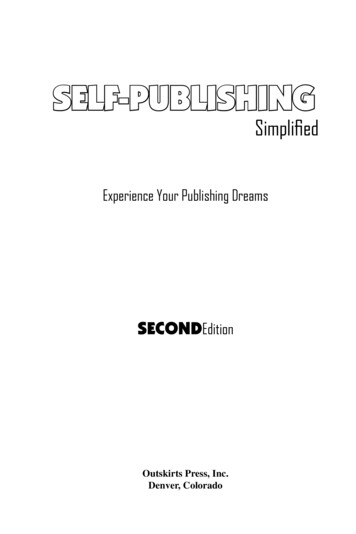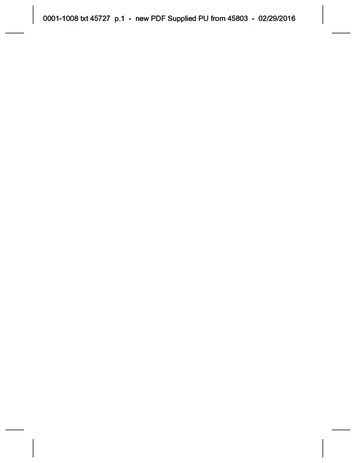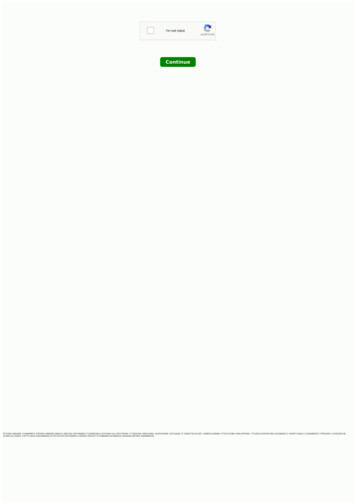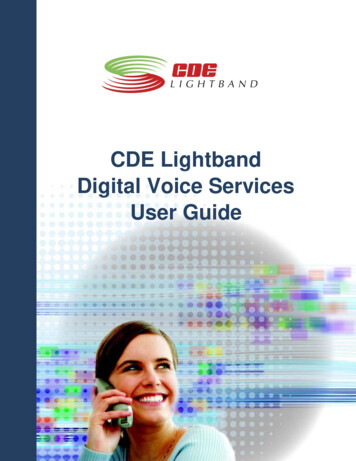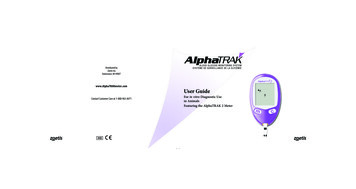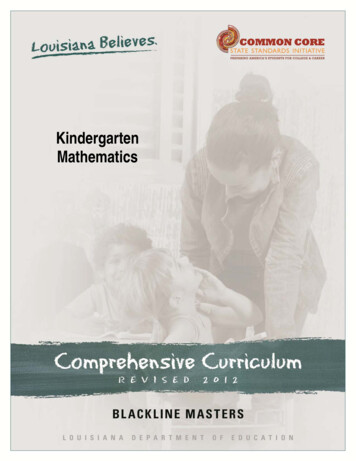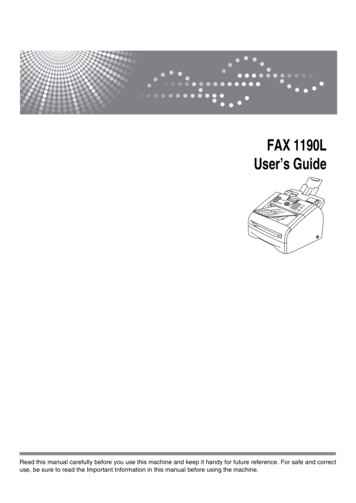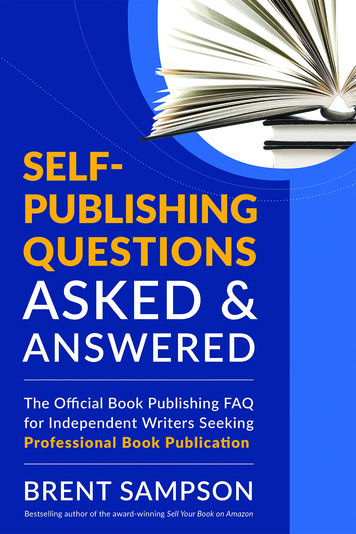
Transcription
Self-Publishing Questions Asked & Answered7KH 2൶FLDO %RRN 3XEOLVKLQJ ) 4 IRU ,QGHSHQGHQW :ULWHUV 6HHNLQJ 3URIHVVLRQDO %RRN 3XEOLFDWLRQAll Rights Reserved.&RS\ULJKW %UHQW 6DPSVRQY 7KH RSLQLRQV H[SUHVVHG LQ WKLV PDQXVFULSW DUH VROHO\ WKH RSLQLRQV RI WKH DXWKRU DQG GR QRW UHSUHVHQW WKH RSLQLRQV RU WKRXJKWV RI WKH SXEOLVKHU 7KH DXWKRU KDV UHSUHVHQWHG DQG ZDUUDQWHG IXOO RZQHUVKLS DQG RU OHJDO ULJKW WR SXEOLVK DOO WKH PDWHULDOV LQ WKLV ERRN 7KLV ERRN PD\ QRW EH UHSURGXFHG WUDQVPLWWHG RU VWRUHG LQ ZKROH RU LQ SDUW E\ DQ\ PHDQV LQFOXGLQJ JUDSKLF HOHFWURQLF RU PHFKDQLFDO ZLWKRXW WKH H[SUHVV ZULWWHQ FRQVHQW RI WKH SXEOLVKHU H[FHSW LQ WKH FDVH RI EULHI TXRWDWLRQV HPERGLHG LQ FULWLFDO DUWLFOHV DQG UHYLHZV 2XWVNLUWV 3UHVV ,QF KWWS ZZZ RXWVNLUWVSUHVV FRP,6%1 &RYHU 3KRWR WKLQNVWRFNSKRWRV FRP OO ULJKWV UHVHUYHG XVHG ZLWK SHUPLVVLRQ 2XWVNLUWV 3UHVV DQG WKH ³23 ORJR DUH WUDGHPDUNV EHORQJLQJ WR 2XWVNLUWV 3UHVV ,QF 35,17(' ,1 7 ( 81,7(' 67 7(6 2) 0(5,& TM
CONTENTSPART ONE3What is self-publishing?5Why self-publish?7What is the difference between “independent”self-publishing, “free” self-publishing, and“full-service” self-publishing?10What is the difference between a “free” self-publishingcompany and a “full-service” self-publishing company?13What self-publishing company should I choose, andwhy?PART TWO17How do I start the self-publishing process?20What is involved in the pre-production process?22What genre of book am I publishing?25What should I title my book?30How do I price my book?34Should I invest in professional editing?37What is the best way to submit my manuscript?40What is the best way to submit my cover?43What is involved in the production process?
45What is an ISBN and why is it important?47What is copyright and why is it important?50How important is an author photo and/or authorbiography?55What can I do to ensure a professional bookpublication?PART THREE61What is book marketing?63What is a marketing plan?67What are the 20 most efficient & effective ways tomarket my book?77How do I host a successful book launch party?84How do I get book reviews on Amazon?89Should I give away my book in order to market it?95Should I enter book contests?100Afterword
PARTONE
WHAT IS SELF-PUBLISHING?ACCORDING TO WIKIPEDIA, self-publishing is the pub-lication of a book where the author is in control of theentire process, including format selection, pricing, coverdesign, interior design, inventory management, distribution, marketing, and public relations. Authors eitherelect to do everything themselves (which can be quitetime-consuming or could possibly lead to a less-than-optimal outcome) or they outsource the work to multipleindependent contractors or to a single self-publishingcompany that offers all the services they need.738
Self-publishing may be experiencing a heyday, but it isnothing new. Homemaker Irma S. Rombauer independently published The Joy of Cooking in 1931. Five years later, theBobbs-Merrill Company acquired the rights and then thingsreally started cooking for Ms. Rombauer (in the form of over 18million copies sold)! Her book wouldn’t be the runaway successit is today without self-publishing.Before Matt Damon showed Mars who was boss in theHollywood blockbuster The Martian, sci-fi writer Andy Weirreleased the book (his debut novel, by the way) chapter-bychapter on his blog before self-publishing it as an e-book in2011. Crown Publishing purchased the rights and re-releasedit in 2014, just months after Twentieth Century Fox optionedthe film rights. Weir went on to win multiple awards, includinga Hugo for Best New Writer, and the film went on to gross over 200 million worldwide.And, of course, there is the story of Fifty Shades of Grey,which started off as Twilight fan fiction on E.L. James’ websitebefore being self-published through a small Australian company. Vintage Books subsequently picked up the rights, republished it (to the tune of 70 million copies), and paved the way fora movie trilogy in the process. To call it a self-publishing successwould be an understatement.The key difference between The Joy of Cooking and the second two examples is that Ms. Rombauer had to spend considerable amounts of time and money designing her manuscriptfor publication, purchasing bulk copies, storing her inventory,and seeking wholesalers, distributors, and retailers to carrythe book. Nowadays, advances in print-on-demand and e-booktechnology have empowered authors like Weir and James (andyou?) to publish professionally and affordably.748
WHY SELF-PUBLISH?2008 MARKED THE first time in history that more bookswere independently self-published than published traditionally. By 2009, 76% of all books released were selfpublished. These trends show no signs of slowing down.In fact, in 2015, the sales of all independently self-published books exceeded the sales of all books publishedby “the big five” traditional publishing houses.In other words, it’s a great time to be a self-publishing writer! Some writers migrate from traditional publishing to self-publishing because they appreciate thegreater degree of control they have over their story,758
their rights, and their careers. Others pour their hearts andsouls into manuscripts that, for whatever reason, traditionalpublishing doesn’t show an interest in, so they turn to self-publishing as a means to share their stories with the world.By now, almost all writers realize that every publishingroute (even traditional ones) require the author to be involvedin the marketing process. So they figure, if they’re going to putforth that much effort, they should make more of the money.Traditional publishing typically pays 5%-10% of the net profitfrom book sales, while self-publishing typically pays between50%-100% of the net profits. Everyone, even right-brained creative types, can identify the best choice there.Regardless of the reason, self-publishing grants all authorsthe opportunity to leave their legacy and their mark on theworld. Life may be fleeting, but books live forever.The main reason most authors shy away from self-publishing is because they want to be accepted by a traditional publisher. They want to have movies made out of their books. Andthey’re afraid self-publishing will hurt their chances. But as youcan see from The Joy of Cooking, The Martian, and Fifty Shades ofGrey, self-publishing isn’t a roadblock to that goal. It’s a stepping stone.In fact, it’s a stepping stone to all of your goals as a writer.Why self-publish? Why wouldn’t you?768
WHAT IS THE DIFFERENCEBETWEEN “INDEPENDENT”SELF-PUBLISHING, “FREE” SELFPUBLISHING, AND “FULL-SERVICE”SELF-PUBLISHING?EVEN THOUGH SELF-PUBLISHING is easier and moreaccessible than it has ever been, it is still difficult if youtry to tackle it alone, which is what you’re doing with“independent” self-publishing. There are standardizedrequirements like ISBNs, EAN barcodes, and meta data.There are creative considerations like cover design andinterior formatting. There are logistic complications like778
wholesaling, worldwide distribution, inventory management,and taxes.Getting those important steps wrong can mean somethingas “inconsequential” as missing out on book awards, or as “significant” as an IRS audit. That is why more and more writers areturning to full-service self-publishing companies to handle thedetails for them. And that is also why being a “published author” is still a remarkable achievement. No matter how you goabout “getting published,” 9-out-of-10 people are going to bevery impressed when they see your book for sale on Amazon.And they should be. It is impressive.You also want them to continue to be impressed when theyactually see your book, don’t you? And that’s the main difference between “free” self-publishing and “full-service” self-publishing. “Free” self-publishing usually delivers an unimpressivebook while “full-service” self-publishing makes sure your published book is just as impressive as your finished manuscript.Besides, “free” isn’t really free. Those websites are moreakin to “freemium” business models. According to Wikipedia,“freemium” is a term coined in 2006 and is the pricing strategyby which a product or service (typically a digital offering suchas software, media, games or web services) is provided free ofcharge; but money (premium) is charged for proprietary features, functionality, or virtual goods.What does this have to do with self-publishing? Well, alot, as it turns out. Many “free” self-publishing companies usethis exact same business model, although the population atlarge hasn’t quite identified the similarities between mobileapps that do this, and businesses in general that do this. Butif you look closely enough, you can identify all the same practices, because some of the largest self-publishing companies788
are actually “freemium” in nature. They tout“free” on their website, but once you drinkthe Kool-Aid, you discover what you probablysuspected all along: Nothing is free. And suddenly you’re paying 999 for a custom cover(instead of 500 or less at other publishers)or 3,000 for a book video (instead of 1,000or less at other publishers).You see, freemium self-publishers use tactics that include overcharging for additionalservices (like the custom covers and bookvideos mentioned above), overcharging forauthor copies, and the coup-de-grace: manipulating authors into giving away their books under the guise of “marketing”, but only if theyrefrain from selling their books anywhereelse. Unwittingly, authors find themselvesin de facto exclusive contracts simply for the“privilege” of giving away their books for free.Talk about adding insult to injury.Most authors are so attracted to the “free”part that they don’t bother to investigatethese other long-term costs. In other words,there is no such thing as “free.”798Apple and itsiTunes appstore receivedso much heatover “free”mobile appswhich, inreality, werenot free, thatthey had to reidentify themas “freemium”applicationsand disclosethe manner inwhich thoseapps actuallymade money.
WHAT IS THE DIFFERENCEBETWEEN A “FREE”SELF-PUBLISHING COMPANYAND A “FULL-SERVICE”SELF-PUBLISHING COMPANY?THE IMPORTANT THING to realize is that publishing is abusiness, and businesses need to make money in orderto stay in business. There is no such thing as a “free” selfpublishing company; a more accurate term is a “freemium” self-publishing company, much like apps fromthe app store, that are free initially, but start becomingmore expensive the more you use them.7108
Freemium self-publishing companies and full-service selfpublishing companies operate on different business models.Freemium services market “free” to attract massive amounts ofclients, and then overcharge the small percentage of them whobecome “addicted” to the amazing feeling of being publishedand subsequently start pouring money into future books thatwould otherwise be less expensive to publish elsewhere (andmore profitable, royalty-wise). These clients are called “whales”in the app-world (there are many psychological articles on thesubject), and ultimately these “whales” end up paying muchmore than they would anywhere else. They end up making lessroyalties than they would anywhere else; and they probablydon’t even realize they are subsidizing all the other clients whoare using the service for free.A freemium company does not offer the level of service orsupport that a full-service company does because it doesn’thave to. Its only marketing claim is “free” and it relies on itsbusiness model for the rest. “Whales” who wish to order services as an add-on do so at a much higher upcharge than similarservices would cost at a full-service company. Again, those whopurchase the add-ons are subsidizing those who do not.Finally, when you consider the largest freemium publisheris also the largest book retailer, you realize they are doubledipping your royalties on the front-end (as the “publisher”) andthe back-end (as the “retailer”). In other words, they are taking a greater percentage of the book’s royalties, which alsomeans successful authors find themselves subsidizing unsuccessful ones. It’s never quite clear how freemium companiesmake money, so many authors make the mistake of assumingthey’re offering a great service to authors out of the goodnessof their hearts. In reality, the opposite may be true – they’re7118
probably making more money by the time you tabulate higheradd-on costs, lower royalties, and forced exclusivities. In theapp world, 90% of game revenue is generated by “freemium”games while only 10% is generated by games that have an initialcost. Are freemium game companies making free games out ofthe goodness of their hearts? Clearly not. So, too, are freemiumpublishers profiting greatly from writers — not only throughhigher upcharges and double-dipping royalties, but by offering“free” content that allows them to sell streaming subscriptionservices, yearly memberships, and electronic equipment, noneof which their authors profit from.Full-service self-publishing companies offer high-quality,professional publishing services to authors in exchange fora fee, much like any other service business (lawyers, accountants, therapists, etc.). It’s always clear how self-publishingcompanies make their money because an author typically orders a service, pays for it, and then receives it.7128
WHAT SELF-PUBLISHINGCOMPANY SHOULD I CHOOSE,AND WHY?THE FIRST DECISION to make is whether you want topublish under the freemium model where you performall the design work yourself (possibly resulting in abook that looks amateurish), or with a full-service selfpublishing company (which requires more of a financialinvestment up front). Certainly, if the price were thesame between both options, everyone would choosefull-service; their books deserve the extra quality. So itusually comes down to an author’s budget. This is whysome self-publishing companies nowadays offer scheduled payment plans, work with online credit services7138
like PayPal Credit, and can even get the author started for aslittle as 35 up front.In either case, do your research. There are a number of resources that offer “reviews” of self-publishing companies andyou should compare them. Reviewing multiple resources beatsrelying upon any one source (whether it be positive or negative) since it’s important to realize that single sources may lackknowledge, integrity, or applicability. Ultimately, a single sourceis just one person’s opinion. You will find that some sourceshate certain companies and love others. Different sources willhave the exact opposite opinions.Whenever you look at any source for any information, youshould consider the date of the information and that source’svested interest. By combining the sources together to arriveupon a “sum total” you are better equipped to see an accurate“average score” of the companies you are examining.Here’s one to start with:TopConsumerReviews.com/self-publishing7148
PARTTWO
HOW DO I START THESELF-PUBLISHING PROCESS?YOUR SELF-PUBLISHING PROCESS will depend uponwhat path you take. If you decide to do it truly independently, without using any experts or online services,you will be wearing many hats – some of them creativeand some of them logistic. Most writers are more rightbrained than left-brained, so the business aspects of“publishing a book” become quite daunting. It is for thisreason that the vast majority of self-publishing writersseek the help of experts or online publishing servicesto assist them. They want to publish a book; they don’twant to learn how to publish a book. Therefore, explaining how to start the process of independently publishing7178
a book yourself is beyond the scope of this book, other than tosuggest reading other books on the subject.If you are publishing with a freemium self-publisher, you willfirst need to address the design responsibilities, since freemium publishers require you to submit documents that are readyto publish. Some freemium publishers “convert” your wordprocessor files for you automatically, but no matter how easyand cheap that seems, you do not want a computer “designing”your book for you; it will look like a computer designed it, whichis the last thing you want. In 99% of the cases, you also do notwant to handle the design responsibilities personally (no matter how easy and cheap that seems). Designing a professionalbook requires professional software and the know-how to useit proficiently. The software cost is reasonable (around a couple hundred dollars), but competent designers are expensive.Using your word processor may sound like an easy and cheapalternative, and it is. But the result? Your book will look easyand cheap.Therefore, beginning the self-publishing process with afreemium publisher begins by looking for publishing professionals. There are many moving parts, and you will find yourself becoming a project manager instead of a writer. Rare is theindividual who can design a book cover and a book interior, soplan on hiring two different designers with different aestheticabilities. You should invest in professional editing, so you willneed to find an editor and vet them to make sure they possessthe ability to edit your book. You will most likely need to hire amarketing expert once the book is published. Identifying, negotiating, and working with four different people is challenging,expensive and time consuming. The best place to find expertslike this is through a writing or publishing organization in your7188
community or city. Finding those associations is beyond thescope of this book, but you can conduct a Google search.When going down the freemium path, you will discoverthat, all of a sudden, you are a “publisher” instead of a “writer.”For some authors, this is an acceptable metamorphosis, butfor most, they do not want to learn all the in’s and out’s of howto publish a professional book, they just want their book to bepublished for them.As a result, most writers who desire a professional publication (and what’s the point of publishing a non-professionalbook?), hire a full-service publishing firm to help them reachthat goal. That process starts easily enough: Find your selfpublishing company of choice and call them on the phone. Tellthem you have a book you need help publishing. They’ll handlethe heavy-lifting for you while you maintain complete controlover your content and material.With the assistance and advice of your full-service publishing experts, you will select your format (paperback, hardback,e-book, etc.); you will dictate the look of your interior and cover(while accomplished artisans actually do the work for you); youwill set your retail price (make sure to choose a company thatallows this); and then you will grab a glass of lemonade whileyour production team members go to work. Of course, you’llget a chance to review and approve everything at every stageto make sure it’s exactly the book you want to publish beforeanyone else sees it.7198
WHAT IS INVOLVED IN THEPRE-PRODUCTION PROCESS?THE PRE-PRODUCTION PROCESS at a freemium self-pub-lisher is the period of time when you make decisions regarding the format of your book, the interior layout design,the cover design, the level of editing, and then complete allthat work yourself (or locate professionals to do it for you).Conversely, the pre-production process at a full-service self-publishing company is the period of time whenyou make decisions regarding the format of your book,the interior layout design, the cover design, the level ofediting, and what sort of pricing your book will have.Then once those decisions are made with the advice ofyour publishing expert, the actual work is done for you7208
and you review the work as it is done on your behalf.All self-publishing companies (freemium and full-service)simplify this part of the process by narrowing your choices. Thenumber of formats you get to choose from varies from place toplace, but is not infinite like it would be if you independentlypublished on your own. Interior design and cover design processes are flexible, but still procedural in nature. The best selfpublishing pre-production processes provide the impressionof free-will while keeping you focused enough to actually complete the steps. You do not want to become so over-burdenedby choices that you never choose anything. That is anotherdanger of traveling this path alone, and another advantage ofhaving a professional publishing company by your side.That is never more true than with pricing. If you independently publish your book without the assistance of experts oran online publishing service (freemium or full-service), you canprice your book however you want. Sure, there are formulas or“best practices” to consider, but the pricing is ultimately up toyou. If you make a mistake, you may discover that your retailprice doesn’t pay for your printing cost, and you may end up losing money every time you sell a book. Retail price, wholesaleprice, distributor price, sales price, discounting, etc. – theseare complicated considerations for which most self-publishingfirms have established parameters to protect their authors.The most common parameter is limitation. Most self-publishing firms will not allow authors to set their own book pricing at all.A select few will grant you some control over your book’s retailprice. An even smaller group will give you control over the authordiscount, trade discount, and royalty you earn. This allows you tosqueeze every last dime out of every book you sell, so these arethe full-service self-publishing firms you want to consider.7218
WHAT GENRE OF BOOKAM I PUBLISHING?BISAC STANDS FOR Book Industry Standards andCommunications and these subject codes are an industry-approved list of nine-character alphanumeric codesthat represent broad descriptors of genre or subjectmatter. There are thousands of BISAC codes, and theyallow retailers, libraries, and online retail stores to accurately catalogue and “place” your book among theirmillions of other offerings. But accurate categorizationonly occurs if your book has the proper BISAC codes.During your online pre-production process at theself-publishing firm you have selected, you will be askedto select the “main genre” for your book. In some cases7228
you may also be asked to select two secondary genres. Thisselection process allows the publisher to identify the BISACcodes for your book, but the accuracy of said codes is only asaccurate as your submission.Why is it so important to choose the right genre for yourbook? Not only does your genre get placed on the back cover ofyour book, but it also determines your BISAC codes, which arepassed to Ingram Wholesalers during the distribution process.Ingram, in turn, shares your book's BISAC codes with every library and retailer. Libraries and retailers use BISAC codes todetermine how they will categorize and list your book.You can see the result of three BISAC code selections onAmazon:In the case of this specific book, you can see that Amazonhas placed it into three very specific categories based upon theBISAC codes provided to them from Ingram: Book Industry,Web Marketing, and E-Commerce. You will also see that at thetime of this screen shot, the book enjoys a “Best Sellers Ranking”of #23, #148, and #289, respectively. When authors call themselves “Amazon #1 Bestsellers” they are usually referring to an7238
Amazon Best Sellers Rank within a specific category. And thosespecific category listings are the result of selecting the properBISAC code, which is the result of selecting the proper genre/subject for your book at the time of pre-publication.7248
WHAT SHOULD ITITLE MY BOOK?IN THIS DAY and age of social media, 140-character limi-tations, websites, and shorter attention spans, a longtitle is a risky title. Short titles make for better domainnames, better tweets, better links, and easier searches.If your book requires a longer title due to its complexity, consider an abbreviated title, and then a longer, keyword-infused subtitle.That's not to suggest you use one-word titles, either.Those are just as dangerous, because single words areeither nouns, verbs, or adjectives. It is difficult to beunique with such a common type of word. For example,Heaven may be the ideal title for your book, but do you7258
really want to compete with the 481 million results that Googlefinds?A three-to-four-word title is optimal. It's short enough formarketing, promotion, and today's attention spans, while stilloffering enough flexibility to follow the rest of the rules below.Examples:The Grapes of Wrath. The Great Gatsby. Crime and Punishment.A book title must be easy to remember. If your marketingefforts are paying off, you may reach the attention of a potential buyer when he or she is otherwise preoccupied. But if yourbook title is easy to remember, you increase the chances of thatperson finding it later that day on Amazon. Word-of-mouth advertising is the best advertising there is, but only if the mouthsremember what to say. There are several tricks to creating amemorable title: alliteration, contradiction, and provocation.Examples:Of Mice and Men. War and Peace. To Kill a Mockingbird.Book titles must be easy to pronounce. That means no longwords. Titles that are difficult to pronounce are difficult to remember, and therefore difficult to buy. And it makes word-ofmouth advertising that much harder, because no one wants tobe embarrassed by mispronouncing a book title.Examples:The Godfather. Moby Dick. Tom Sawyer.7268
A book title should be unique. Granted, with over one million titles published annually, this is becoming the exception,rather than the rule. But, nevertheless, make every effort toarrive upon a wholly original and unique title for your book.Conduct a Google search and then search on Amazon. See whatcomes up in the results and ask yourself if you want to competewith the results you see. The Sound and the Fury may be the perfect title for your book, but do you really want to compete withWilliam Faulkner?Examples:The Catcher in the Rye. Gulliver's Travels.The Adventures of Huckleberry Finn.A book title has to evoke some sort of emotional response:happiness, fear, curiosity, even disgust. Just make sure it strikesa chord. Your title has to conjure feelings within the reader toincrease the chances of closing the sale.Examples:Great Expectations. As I Lay Dying. American Psycho.Now that we’ve discussed your book title, let’s discuss yoursubtitle, which follows almost the exact opposite rules as yourtitle. Your subtitle should be long. It probably won’t be easy toremember. Some words might not even be easy to pronounce.And it probably won’t evoke any emotions. That’s not its purpose. Its purpose is to capture the attention of search engines.So it should be unique. In fact, if you type in your subtitle exactly, it should be the only exact match on Google and Amazon.7278
If it’s not, give it a tweak.Today's savvy authors infuse their subtitle with descriptive, relevant keywords or phrases to appear higher in searchresults. When a book buyer wants to solve a particular problem, they type keywords related to that problem into Googleor Amazon, and look at the results for the most promising solution. If you have written a non-fiction book addressing thatvery problem, you want to ensure your book comes up high inthose search results. The way you rank higher in organic searchresults is by creating a subtitle rich in relevant keywords.While a long, keyword/phrase-infused subtitle is less applicable to fiction books (and even less so to poetry and children'sbooks), it never hurts to include a subtitle. Is a buyer interestedin futuristic detective novels more likely to buy a novel titled TheWatch List, or is he more likely to buy The Watch List: A MysteryThriller in the 21st Century? Is a reader interested in Tahitianlove stories more likely to buy a novel titled Summer Seclusion,or is she more likely to buy Summer Seclusion: A Romance on theSouthern Seas?Remember, long, descriptive, keyword-infused subtitlesdon't need to play a role in your cover design. In fact, in mostcases, the longer it is, the better off you are if you don't includeit on the cover. So be sure to instruct your book designer ofthat intention when coordinating with him or her. But you dowant to include your subtitle when you are (or your publisheris) submitting your book to Amazon, Ingram, Barnes & Noble,and all the other worldwide outlets available through nearlyall full-service self-publishing companies.7288
Example:The Book Marketing COACH: Effective, Fast, and (Mostly)Free Marketing Tactics for Self-Publishing Authors.Once you have a title you feel satisfies all these considerations as well as possible, give it a try and see if it sticks! Writerstoday have the best market research tool around. It's called theInternet. If you already have a blog on WordPress (and if youdon't, you should go create one today), you can develop a posting that asks your followers to vote on your various title/subtitle creations. WordPress blogs even have a Poll applicationthat makes it easy. If you don't have a blog, ask your Facebookfollowers to voice their opinions on your title.In addition to the market research you're going to receive,this is a savvy way to introduce your upcoming book to yourfriends and family. When they start asking when they can buya copy, you'll already know you have some book sales in yourfuture.7298
HOW DO I PRICE MY BOOK?EVERY SELF-PUBLISHING COMPANY nowadays (free-mium and full-service) uses print-on-demand printingtechnology to produce physical copies of their author/clients’ books. This allows the publisher and their author/clients to manage/limit excess inventory, whichdecreases risk. That’s the upside. The downside is thatproducing a book one-at-a-time increases the per-unitco
from book sales, while self-publishing typically pays between 50%-100% of the net profits. Everyone, even right-brained cre- . that are free initially, but start becoming more expensive the more you use them. 7 11 8 Freemium self-publishing companies and full-service self- . royalty-wise). These clients are called "whales" in the app .
